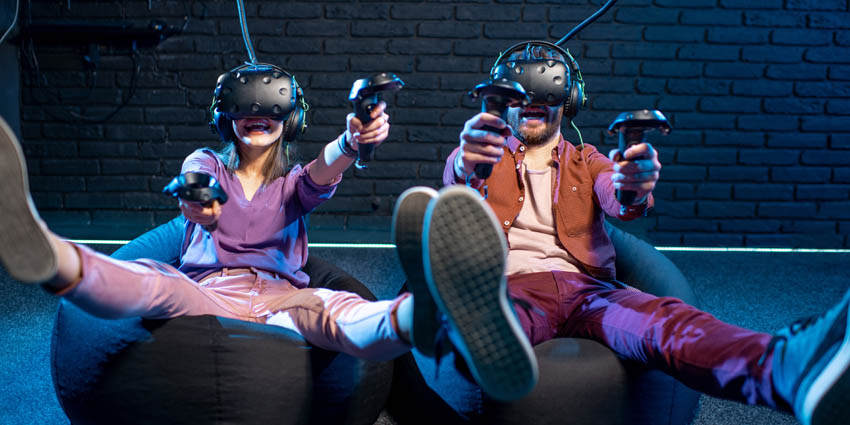Gaming’s Next Frontier Uses Groundbreaking Technologies for Player Experience

The world of gaming is in a state of perpetual revolution, constantly evolving and redefining the boundaries of interactive entertainment. What was once a simple form of solitary escapism has exploded into a multifaceted global phenomenon that is a central part of our culture. This isn’t just about faster graphics or more powerful consoles; it’s about a profound paradigm shift, driven by a convergence of groundbreaking technologies, a new generation of digital-native players, and a fundamental rethinking of the player experience. This article will take a deep dive into the gaming’s next frontier, exploring the core trends defining this new era, from the rise of cloud gaming and the integration of artificial intelligence (AI) to the burgeoning world of the metaverse and the new focus on holistic player wellness. We will look at the technologies that are making these changes possible, the games that are pushing the boundaries, and the immense opportunities and challenges that lie ahead for the future of entertainment.
The Core Trends of the New Era

The gaming world of today is a far cry from the consoles and cartridges of the past. It is a dynamic and interconnected landscape defined by several key trends that are blurring the lines between the digital and physical worlds.
A. The Metaverse
The metaverse, once a futuristic concept, is becoming a tangible space where people can socialize, work, and play in a shared virtual world. This isn’t just a single platform; it’s a vast network of interconnected virtual worlds, each with its own unique culture, economy, and community. The metaverse is a new social hub, a new form of entertainment, and a new frontier for creativity and self-expression. It’s a space where a player can build a home, a business, or a community, and where they can connect with people from around the world in a way that feels more natural and immersive than a simple video call. The ultimate goal of the metaverse is to be a persistent, always-on virtual world that continues to exist and evolve even when a player is not in it.
B. Cloud Gaming’s Ubiquity
The era of expensive gaming hardware is nearing its end. Cloud gaming has gone mainstream, allowing players to stream high-fidelity games to any device with an internet connection—be it a smartphone, a smart TV, or a low-end laptop. This democratizes access to the most demanding games and eliminates the need for expensive hardware upgrades. The player’s device becomes a simple window to a powerful server, allowing for a seamless and high-quality gaming experience anywhere, anytime. This is a game-changer for casual players and for those in regions with limited access to expensive gaming hardware. The proliferation of 5G networks is a major catalyst for cloud gaming, as its high speed and low latency are the perfect foundation for a seamless streaming experience.
C. The AI-Powered Experience
Artificial intelligence is no longer just for non-player characters (NPCs) with simple scripts. In this new era, AI is a core part of the gaming experience, creating more dynamic, personalized, and responsive worlds.
- Dynamic Storytelling: AI can now dynamically alter a game’s narrative based on a player’s choices and actions. This creates a unique and personalized story for every player, making each playthrough a new and unpredictable adventure.
- Generative Content: AI can generate new game content—from quests and landscapes to dialogue and enemy behavior—on the fly. This allows for massive, ever-evolving worlds that never feel repetitive or static.
- Intelligent NPCs: NPCs are becoming more intelligent and lifelike. They can learn from a player’s behavior, remember past interactions, and react in a way that feels organic and authentic. This creates a new level of immersion and a deeper connection to the game’s world.
The New Player Experience
The next frontier of gaming is not just about a better game; it’s about a more holistic and meaningful experience for the player. The industry is starting to recognize its responsibility to the player’s well-being, and a new focus on wellness and community is changing how games are designed and how players interact with them.
A. Gaming for Wellness
Video games are being designed not just for entertainment but for their therapeutic and cognitive benefits.
- Stress Reduction: Games with a focus on mindfulness, puzzle-solving, and a calm aesthetic are being used to help players de-stress and relax. The immersive and engaging nature of a game can act as a form of mindfulness, helping to divert attention away from anxious thoughts and worries.
- Cognitive Enhancement: Games that challenge a player’s memory, problem-solving skills, and reaction time are being used to improve cognitive function and to help with conditions like ADHD.
- Physical Activity: VR games are providing a new, fun way for people to exercise. Full-body VR workouts and fitness titles are gaining a massive following, turning a sedentary hobby into a physical one.
B. The Social Gaming Experience
The best games in this new era are not just about a single player; they are about a shared, social experience.
- Cross-Platform Play: The ability for players on different devices and platforms to play together has become standard. This creates a new level of social connectivity and a larger community for every game.
- In-Game Communities: Games are becoming social hubs where people can not only play together but also form communities, make new friends, and share their creativity. The bonds that are formed over a shared mission or a late-night gaming session are as real and as lasting as the ones that are formed in a physical setting.
- Holistic Community Management: The best gaming companies are investing in community managers and AI-powered tools to ensure that their online communities are safe, inclusive, and welcoming for everyone.
Challenges and Opportunities

While the future of gaming is bright, there are significant challenges that must be addressed to ensure that this revolution is inclusive and sustainable.
A. The Digital Divide
The full benefits of cloud gaming and the metaverse are dependent on a player’s access to a high-speed internet connection. This creates a new digital divide, where individuals in regions with limited infrastructure are left behind. Closing this gap is a crucial step for the future of gaming.
B. Data Privacy and Security
The integration of AI, biometric data, and the metaverse in gaming raises serious concerns about data privacy and security. Companies must be transparent about how they collect, store, and use a player’s data, and new regulations will be needed to protect a user’s privacy in these immersive digital worlds. The immense amount of data being generated by a player in a metaverse, from their eye movements to their social interactions, is a prime target for cybercriminals and malicious actors.
C. The Ethical Use of AI and User-Generated Content
The power of AI in game development also raises a number of ethical questions. How do we ensure that AI-generated content is not plagiarized? How do we ensure that AI-powered NPCs do not perpetuate harmful stereotypes? The gaming community and developers must work together to create a set of ethical guidelines for the use of AI in gaming. The rise of user-generated content in the metaverse also raises a new set of legal and ethical questions about copyright, intellectual property, and moderation.
Conclusion
The next frontier of gaming is a testament to a new era of innovation, creativity, and player-centric design. The ubiquity of cloud gaming has made high-fidelity entertainment accessible to everyone, dismantling the barriers of expensive hardware. The integration of artificial intelligence is fundamentally changing how we play, creating dynamic, personalized, and ever-evolving worlds that are as unpredictable as they are immersive. The burgeoning metaverse is blurring the lines between the digital and physical realms, opening up a world of new possibilities for social interaction, work, and education.
However, as we celebrate these milestones, we must also confront the significant challenges that lie ahead. The digital divide, data privacy, and the ethical use of AI and user-generated content are not just technical hurdles; they are fundamental issues that will define the future of gaming. The industry’s new focus on player wellness and a holistic approach to the gaming experience is a positive step forward, but more work is needed to ensure that our digital worlds are not only fun but also safe, inclusive, and healthy for everyone. The future of gaming is not just about faster consoles or better graphics; it’s about a new kind of entertainment that connects us, empowers us, and challenges us in a way that is as unique and personal as we are. The next frontier of gaming is a journey of incredible promise, and the future of play has never been more exciting.

